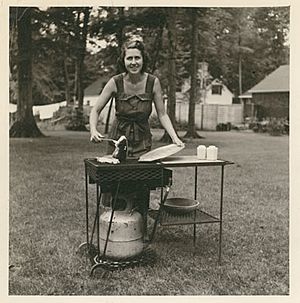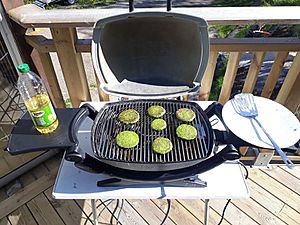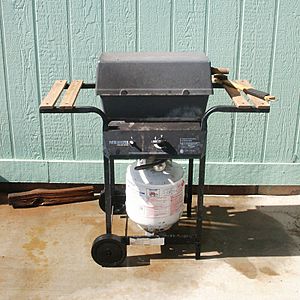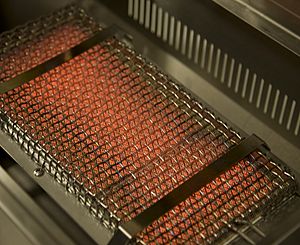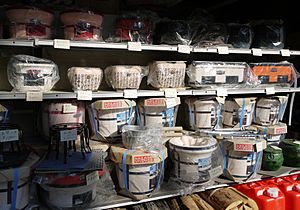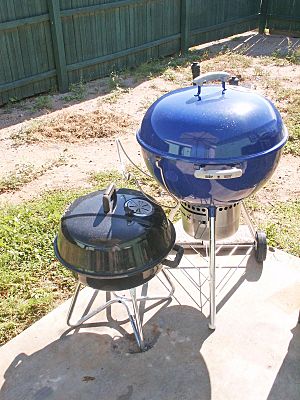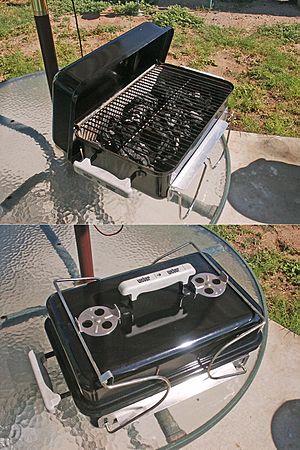Barbecue grill facts for kids
A barbecue grill is a cool device that cooks food using heat from below. People often just call it a "barbecue" or "barbie," especially in Australia and New Zealand. Grills come in different types. The main ones use gas, charcoal, or electricity. Many people like to debate which type cooks food the best!
History of Grilling
Early Grilling in the Americas
People have been grilling in the Americas for a very long time, even before Europeans arrived. The Arawak people in South America cooked meat on a wooden frame called a barbacoa. For many years, barbacoa meant the wooden frame itself, not the cooking method. Later, the word changed to "barbecue" and described the way food was cooked.
This cooking style was also used in the southeastern United States. It was first used to slow-cook hogs. Over time, different regions developed their own ways of barbecuing. Today, many different foods are cooked this way, including hamburgers and hot dogs.
Who Invented Modern Grills?
The modern charcoal briquette was invented by Edward G. Kingsford. He worked for Henry Ford, who made the Model T car. Kingsford noticed that Ford's car factories had lots of wood scraps. He suggested turning these scraps into charcoal to sell. This is how the famous Kingsford charcoal company started!
George A. Stephen created the well-known round grill design, which his neighbors jokingly called "Sputnik" (like the satellite). Stephen worked with metal and was tired of wind blowing ash onto his food. So, he took half of a metal buoy, added legs, and made a lid. This became the first Weber-Stephen Products Company grill.
The gas grill was invented in the late 1930s by Don McGlaughlin. His company, LazyMan, made the first built-in gas grill. These early grills used "permanent coals," which were actually lava rocks. In 1954, McGlaughlin also made the first portable gas grill. It was the first to use the 20-pound propane tanks that plumbers used for fuel.
Types of Grills
Electric Grills
An electric grill cooks food using an electric heating element. You don't need charcoal or gas for these grills. They are often used indoors.
Gas Grills
Gas grills usually use propane or natural gas as fuel. The gas flame either cooks food directly or heats other parts that then cook the food. Gas grills come in many sizes, from small ones for one steak to huge ones for restaurants. Some gas grills can even switch between different types of gas.
Most gas grills are "cart grills." This means the grill sits on a wheeled frame that holds the fuel tank. This frame can also have side tables or storage.
Some gas grills have an infrared burner at the back. This burner gives off even heat and is great for cooking meat on a spinning rotisserie. Another popular type is the flattop grill. On these, food cooks on a griddle-like surface and isn't exposed to an open flame.
You can even use a small metal "smoker box" with wood chips on a gas grill. This adds a smoky flavor to your food.
Infrared Grills
Infrared grills work by heating a special ceramic tile with gas. This tile then sends out infrared radiation to cook the food. Infrared grills let you change the cooking temperature easily. They can also get much hotter than regular gas grills, which is great for quickly searing (browning) food.
Charcoal Grills
Charcoal grills use either charcoal briquettes or natural lump charcoal as fuel. When the charcoal burns, it creates hot embers that cook the food.
People who love grilling often argue about which type of charcoal is best. Some like briquettes because they are all the same size and burn evenly. Others prefer natural lump charcoal because it adds a subtle smoky flavor and doesn't have extra ingredients.
Charcoal grills come in many shapes and sizes. They can be square, round, or rectangular. Some have lids, and some have vents to control the heat.
Brazier Grills
The brazier grill is the simplest and cheapest charcoal grill. It's made of wire and metal. It has a cooking grid placed over a charcoal pan. These grills usually don't have a lid or vents. You adjust the heat by moving the cooking grid closer or further from the charcoal.
Pellet Grills
Pellet grills use special hardwood pellets made from sawdust. You load these pellets into a container called a hopper. An electric motor feeds the pellets into a firebox, where they are lit by an electric rod.
Pellet grills are very versatile. They can smoke food at low temperatures (around 100-150°F) or cook at higher temperatures (up to 500°F or even 700°F for searing). They can hold steady temperatures for many hours. This makes them great for smoking, barbecuing, and grilling.
Square Charcoal Grills
The square charcoal grill is a mix between a brazier and a kettle grill. It has a shallow pan like a brazier but also a lid and basic adjustable vents. These grills are often found at discount stores. They usually have wheels so you can tilt and roll them.
Shichirin (Hibachi)
In English, "hibachi" often refers to small cooking grills. They are usually made of aluminum or cast iron. Because they are small, hibachi grills are popular for portable barbecues. They look like traditional Japanese charcoal cooking tools called shichirin.
A hibachi grill usually has a charcoal pan and two small cooking grids. Like brazier grills, they don't have a lid. Some have vents to control heat. Hibachi grills are good if you don't have much space or want to take your grill with you when traveling.
Kettle Grills
The kettle grill is a classic American design. George A. Stephen invented the original Weber kettle grill in 1952. It's still one of the most popular charcoal grills today.
The kettle grill has a lid, cooking grid, charcoal grid, and a round lower part that holds the charcoal. Its special kettle shape helps distribute heat evenly. When the lid is on, it stops flames from dripping grease and lets heat and smoke circulate around the food. This adds flavor!
The kettle design also allows for "indirect cooking." For this, you pile charcoal on one side and place food on the other side, away from the direct heat. This is great for slow cooking. The grill has vents on the bottom and lid to control airflow and temperature.
Cart Grills
The charcoal cart grill looks a lot like a gas grill. It can be rectangular or kettle-shaped. It has a hinged lid, cooking grid, charcoal grid, and is mounted on a cart with wheels and side tables. Many cart grills let you adjust the heat by moving the cooking surface or the charcoal pan. They often have an ash drawer for easy cleaning.
Barrel Grills
A barrel grill is often made from a large steel barrel cut in half. One half forms the lid, and the other forms the charcoal chamber. Vents are added for airflow, and a chimney is usually attached to the lid. Like kettle grills, barrel grills are good for both grilling and slow barbecuing. For slow cooking, you pile charcoal at one end and food at the other.
Ceramic Cookers
The ceramic cooker design has been around for about 3,000 years! The Japanese shichirin grill is traditionally ceramic. More modern designs are influenced by the mushikamado, now called a kamado. Ceramic cookers are very good at keeping heat and moisture inside. This makes them great for grilling, smoking, and barbecuing.
Tandoor Ovens
A tandoor is a special oven used for cooking certain types of Indian and Pakistani food, like tandoori chicken and naan bread. In a tandoor, a wood fire burns at the bottom. Food is placed on long skewers and lowered into the oven from the top. This way, the food gets both direct heat from the coals and hot air from the oven. Tandoors often get very hot (over 500°F) and cook food quickly.
Portable Charcoal Grills
Portable charcoal grills are usually small and easy to carry. They are popular for picnics, camping, and tailgating (cooking at sports events). Their legs often fold up so they fit easily into a car trunk. Most have vents and lids, but some are simpler. Some are even designed to prevent ash from falling out.
There are also "Portable Backpack Grills." These are super lightweight and can fold down to fit inside a regular backpack.
Gravity Fed Grills
Gravity fed charcoal grills have a hopper where you put charcoal briquettes or lump charcoal. A fire is lit at the bottom of the hopper. A fan controlled by a computer helps manage the fire's heat and temperature. The heat and smoke then cook the food. These grills offer the control of a pellet grill but use charcoal.
Hybrid Grills
A hybrid grill can use both charcoal and gas (natural gas or propane). This means you get the convenience of a gas grill with the smoky flavor of charcoal. The gas burners can also help start the charcoal fire quickly. Some newer hybrid grills can even use wood as a fuel source, which is great for emergency situations.
Parts of a Grill
Many parts of a gas grill can be replaced, which helps them last longer. While charcoal grills might just need new cooking grates, gas grills have more parts.
Burners
The burner is the main heat source in a gas grill. They are usually made of stainless steel, aluminized steel, or cast iron. Burners are hollow with holes for gas to come out. Gas mixes with air inside tubes called "venturis." A metal screen covers the air intake to keep spiders from building nests inside!
Cooking Grates
Cooking grates are the surface where your food cooks. They are also called cooking grids. They can be made from:
- Stainless steel: Usually the most expensive and longest-lasting.
- Porcelain-coated cast iron: Good for searing meat.
- Porcelain-coated steel: Lasts well but not as good for searing.
- Cast iron: Common for charcoal grills. Needs oil to prevent rust.
- Chrome-plated steel: Usually the cheapest and doesn't last as long.
When fat or oil drips onto the burners, it can cause "flare-ups" (flames). Some grills have plates or baffles to stop this and protect the food.
Rock Grates
Rock grates sit above the burner and hold lava rock or ceramic briquettes. These rocks protect the burner from drippings and help spread the heat evenly.
Heat Shields
Heat shields are also called burner shields or heat tents. They do the same job as rock grates: protecting the burner and spreading heat. They are lighter and easier to replace than rocks. Heat shields also turn meat drippings into vapor, which adds more flavor to the food.
Valves
Valves control the gas flow to the burners. If a valve breaks, it can be hard to find an exact replacement. Sometimes, grills are thrown away just because a valve fails. If gas isn't reaching the burner, it might be a blockage in the venturi tube, which can often be cleared.
Cover
A barbecue cover is a special cloth cover designed to protect your grill from outdoor weather like sun, wind, rain, and snow. It also keeps out dust and dirt. Covers are often made with a vinyl outer layer and a heat-resistant inner lining. They usually have straps to keep them secure in windy weather.
Indoor Grills
Cooking with a live fire indoors can be dangerous without good ventilation. However, you can still grill indoors! One simple way is to use a steel or cast iron griddle on your stove. These often have raised ridges to create grill marks and let fat drain away. You can also just use a regular frying pan.



